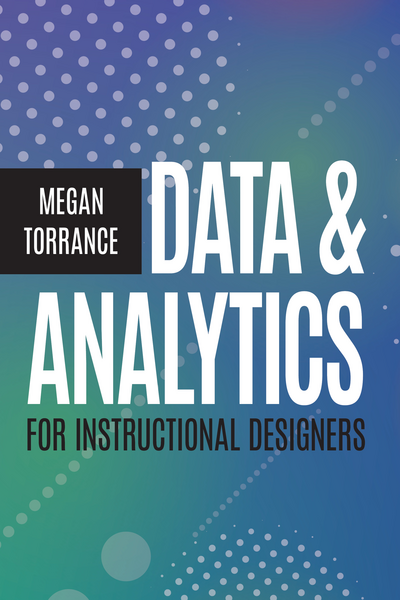ATD Blog
The Data Evolution for Instructional Designers
Mon Apr 10 2023


With the advance of new learning technologies and data specifications, instructional designers have access to richer data sources than ever before. But with more data comes the question of what to do with it. In Data and Analytics for Instructional Designers, instructional design pro Megan Torrance addresses what learning and performance data you need, how to design learning experiences with data collection in mind, and how to use the data to improve and evaluate those experiences. In this Q&A with Torrance she shares what readers can expect to learn in the book.
Why this book, why now? What has changed in the field?
Right now, we’re all in the midst of a data revolution. Data is everywhere, and it’s driving digital transformation across the organization, so it’s no surprise to me that instructional designers are being asked “Where’s the data?!”
In 2015, I founded the xAPI Learning Cohort, with the intent to help learning teams get comfortable with using xAPI so they could lead adoption in their organizations. I really wanted to demystify and democratize access to this new technology. Having helped over 5,000 people get their start through Cohort, next up was a plan to help people do something with the data. That’s what this book is all about.
There are a few things driving this revolution (or evolution). As the learning experiences we design become more complex—think adaptive and personalized learning—many designers and platforms are leveraging data to provide a better experience for the learner. At the same time, these learning programs generate vast amounts of data that we can use to analyze the learning experience, identify what works, and make corresponding improvements.
Learning designers are also looking to evaluate that learning experience in a much more in-depth way than we’ve ever been able to before. New learning platforms and new learning data standards such as xAPI enable us to capture data for evaluation beyond satisfaction scores, completion status, and test scores.
And, it’s about time. I’ve often said that just about every other function in most organizations has more data with which to do their work than the learning and development team.
What are you seeing with your clients and out in the field that says folks need this?
I remember a time early in the days of xAPI when we had built out a large learning program for a client of ours. I mean, it had all things: a behavioral assessment, e-learning, virtual instructor-led training, a mobile performance support tool, a manager coaching kit, and a post-assessment focused on on-the-job application. We asked the client if they would like to use xAPI to get an understanding of engagement with the program. At first, the answer was, “No, that’s OK. We’ll know that they are engaged because they will complete each step of the process in order to move ahead.”
As we built out the program, our team kept asking whether it would be useful to know how people were responding to various activities within the learning program, what kinds of things people were struggling with, and how long it was taking to move from one piece to the next. It took a little bit of coaching, but over time the client realized that completion data alone was not going to tell them what they wanted to know about the program. That’s how we sold the power of data.
What I’m finding lately is that it doesn’t take quite so much convincing to get to this point. Our design and development clients are asking us if what we build for them will send xAPI data. Our learning engineering clients are working with us to set up data-rich ecosystems that will support their IDs use of data and analytics. And I’m finding that larger learning and development teams are building out learning analytics capabilities already.
You’ve written several articles on xAPI for TD magazine and you co-wrote our first TD at Work guide on xAPI. How is this book different from those publications?
This book is not about xAPI. While xAPI is a probably very useful data specification for people using data and analytics, it is not required. There are lots of ways to get data and lots of platforms in which to do analysis. It was important to me that this not be just about xAPI, because I believe that limits the conversation a bit. (Although, yes, we do talk about xAPI in the book!)
How will your book make a difference?
My goal with the book is not to create data scientists but rather to help instructional designers approach this topic with confidence and with a structure and a process for moving forward. I want instructional designers to be able to have meaningful conversations about data with the business intelligence and data science teams and their organizations if they have one, or to lead the way themselves if they do not.
Where is data and analytics going in the future? Does the emergence of AI change things?
I see data literacy and a comfort with analytics as increasingly essential skills for many business professionals, including learning and development professionals. Data is not going away, it’s a new(ish) tool that will support our instructional design work going forward. Artificial intelligence will support us—not replace us—in this work. If anything, I see the rise of artificial intelligence in the processing and analyzing of data—particularly as costs come down and access goes up—as the greater reason to be comfortable with data and analytics.
About the Author
Megan Torrance is CEO and founder of TorranceLearning and has over 25 years of experience in learning design, deployment, and consulting. Megan and the TorranceLearning team are passionate about sharing what works so they devote considerable time to sharing professional development in her field. Megan is the author of Agile for Instructional Designers, Data & Analytics for Instructional Designers, and Making Sense of xAPI. She is also a facilitator with eCornell's Women's Executive Leadership certificate, and courses in virtual teaming, team leadership and communication.
About ATD Press
The Association for Talent Development (ATD) is the world’s largest association dedicated to those who develop talent in organizations. ATD’s members come from more than 120 countries and work in public and private organizations in every industry sector. ATD Press publications are written by industry thought leaders and offer anyone who works with adult learners the best practices, academic theory, and guidance necessary to move the profession forward. For more information, visit td.org/books.
Data and Analytics for Instructional Designers
ISBN: 9781953946447 | 248 Pages | Paperback
To order books from ATD Press, call 800.628.2783.
To schedule an interview with Megan Torrance, please contact Kay Hechler, ATD Press senior marketing manager, at [email protected] or 703.683.8178.
You've Reached ATD Member-only Content
Become an ATD member to continue
Already a member?Sign In
